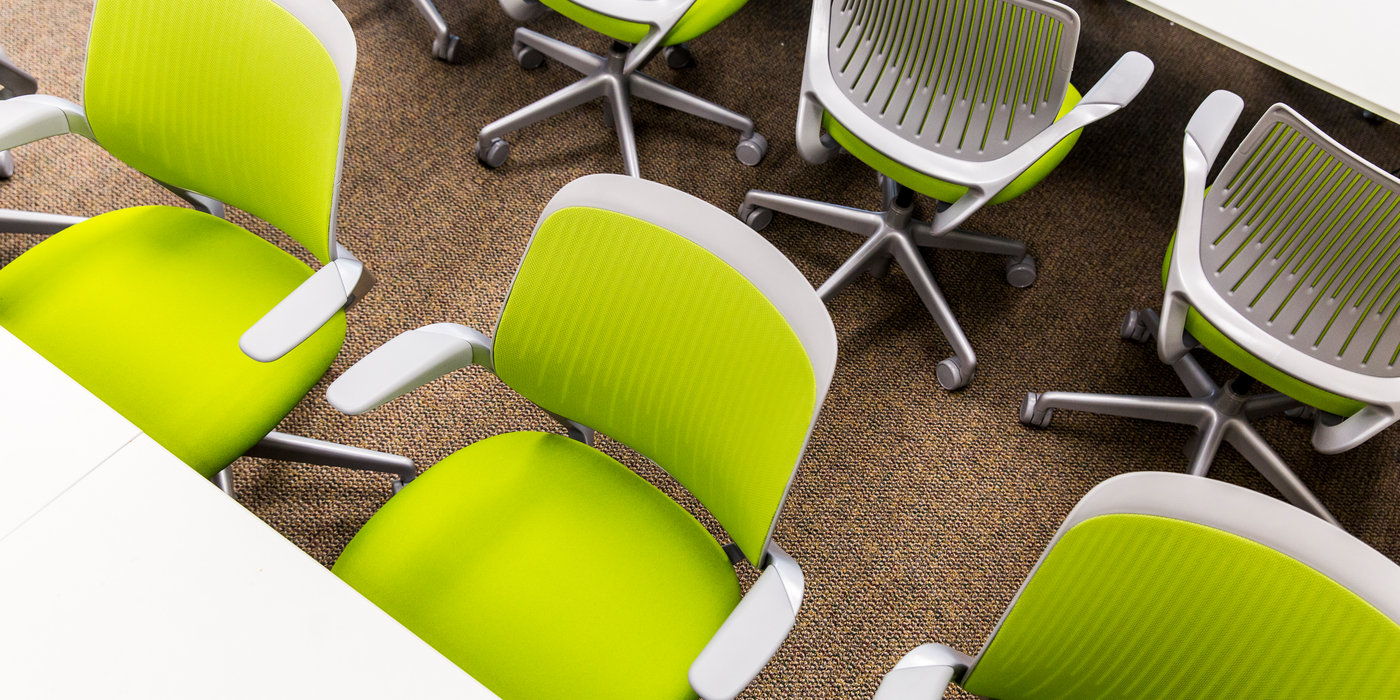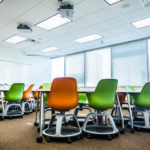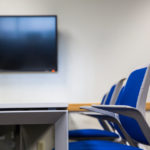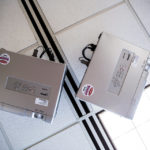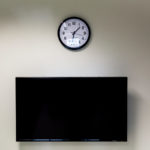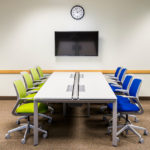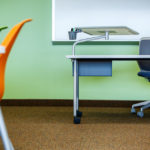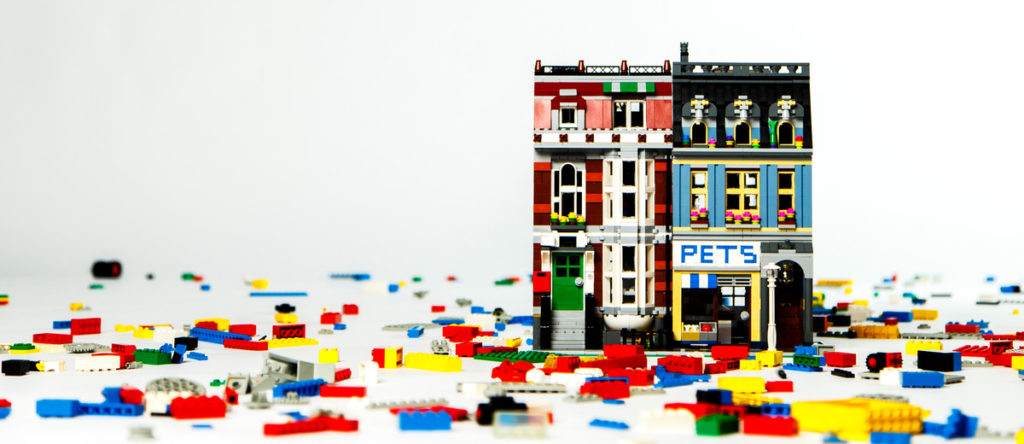When we talk about the future, it’s easy to fall back on jokes about jet packs and flying cars. But in the real world, how do we know when the future has arrived, particularly when it comes to learning environments? We know that it should be different from the inflexible old models of the past: no more rigidly structured rooms with rows of seated students, passively receiving information from an instructor standing at the front. But beyond that, what does a “classroom of the future” look like?
The business landscape of 2014 looks very little like that of 1980; consequently, business education in 2014 should look different, too, to suit the new world of networked, collaborative creativity.
Imagine a space that is designed to encourage an exchange of ideas – everything is maximized for interaction and to foster creativity. The chairs and walls are colorful and complementary, giving the space a feeling of energy. The instructor’s podium is on wheels and is placed at the center or off to the side because there’s no longer a formal front of the room. Students move seamlessly among presentations, large group discussions and small group work, sliding chairs or work stations on casters into new configurations. Rows are banished in favor of clusters of desks or even a giant X formation for better sight lines to classmates and screens. Students have access to whiteboards, huddleboards (markerboards on easels) and multiple screens placed at different vantage points throughout the room or at their own tables.
Working independently is the exception, not the rule, because this new environment is maximized for group analysis and problem-solving. Everyone is expected to contribute.
These learning centers are now a reality in two newly redesigned classrooms and a lab in the Opus College of Business. Formerly configured as traditional classrooms, they have been transformed into spaces that foster active, peer-to-peer learning, freedom of movement for instructors and quick transitions.
The project was a collaborative effort among faculty from each academic department in the University of St. Thomas Opus College of Business, and staff from Steelcase, General Office Products and A/V partner Marco. Planning for the classrooms began in October 2013 and installation was complete by January 2014, making the rooms available for the first day of spring semester.
In Schulze Hall, two undergraduate entrepreneurship courses and four graduate courses in finance, economics, operations and management were held in the “low tech” room, and the Entrepreneurship Lab offered three undergraduate entrepreneurship courses. The “high tech” classroom in Terrence Murphy Hall hosted two sections of a graduate course in new venture finance as well as a graduate elective in marketing and business communication.
The classrooms are a direct response to the way workplaces, and the world, are changing, becoming collaborative and networked environments that often rely on a team approach to solving complex problems. The days of employees spending the majority of their time working independently at desks is already an outdated notion at some innovative companies.
“The classrooms were developed in response to surveys – one focused on technology use and the other on teaching style – in which faculty shared concerns about current classroom configurations,” said Lisa Burke, director of technology in the Opus College of Business, who was part of the planning effort. “There needed to be spaces for innovation that would allow us to determine which elements in them are the most successful and transfer them to the design of other learning spaces.”
The group decided it was imperative that the rooms be geared toward sharing and group work, disrupting the old model of an instructor standing in front and lecturing to students. Here, podiums are on wheels and can be raised or lowered so they work anywhere in the room. Students can slide mobile work stations together or stand at huddleboards to capture ideas and easily share them with the rest of the room. The screen of any laptop or mobile device can be shown on the digital screens at tables in the “high tech” room, as well as to the projectors at the front of the room. Whiteboards can be displayed on rolling carts or hung on the wall. In one room, students write directly on a wall covered with IdeaPaint, essentially making the entire surface one giant whiteboard.
Laura Dunham, Ph.D., associate professor and chair of the Entrepreneurship Department, who taught in the classrooms last spring, noticed that the boards greatly altered the dynamics of her classroom activities. “Now, instead of having small groups hovering around one student with a notepad, all the students are up and working together to add their ideas on the whiteboards,” Dunham said.
“Their work is much more visible. For the group, this stimulates more discussion and debate. The end result is that their analysis becomes much richer and there is more active engagement among all members of the group. As an instructor, it means I can keep better track of each group’s work. I can see who is struggling and needs a little extra guidance, as well as those who are sailing through it.”
Of course, technology plays a key role in each of the rooms. A control station (hub) is placed at the side of the room so its presence is supplemental to learning, not front and center. Stations include document cameras, Sharp 3-D Blu-Ray Disc players, Crestron Digital Media Presentation Systems, wireless keyboards and high-definition Crestron tabletop touch screens.
In the “low-tech” classroom, students sit at tables and chairs outfitted with casters so they can move into various configurations for group work or make it easier to watch presentations on one of the three screens in the room. Projectors are ceiling-mounted along with eight speakers. The “high tech” classroom features Steelcase’s media:scape technology, which allows students to sit at one of five tables with a shared digital display and pucks for plugging in laptops to share content, creating a “walk up and connect” environment.
“With displays at every table that could show my lecture slides with the touch of a button, I felt more free to walk around the room as I was lecturing without feeling like I was forcing students to decide between watching me versus looking at what was at the front of the room,” said Aaron Sackett, Ph.D., assistant professor of marketing, who taught in the “high tech” classroom last spring. “More importantly, it allowed more flexibility when we broke into teams or groups for discussion or assignments.”
In Sackett’s persuasion class, each graduate student is required to present once during the semester and then lead a discussion for about 20 to 30 minutes. Two or three of these presentations per week take up a considerable amount of class time, but the technology and organization of the room allowed him to run multiple student presentations at one time. “Students could still use their laptops or tablets to display visual aids on-screen at their station, and I was able to move from station to station easily,” he said. “The end result was a more intimate presentation and discussion setting for students, and a much more efficient use of class time.”
The classrooms can be seen as incubators, providing a place where students can both sharpen their ability to analyze problems and information and make meaningful contributions to group work. “Because the format in these classrooms is so much more transparent (each group’s analysis goes up on small whiteboards that are readable throughout the room)[students] push themselves harder,” Dunham said. “They dig deeper to understand the problem and think through their analysis and recommendations. And I can track their work and intervene sooner to provide feedback if needed or help explain a tool or framework they are using.” Dunham added that it also makes everyone more accountable – the visibility of working with whiteboards or sharing laptop screens means no one can opt out of contributing without it being apparent to their team and to the instructor.
Sackett agreed, saying, “I think the technology allowed for students to work more collaboratively with each other on many assignments and tasks, and it allowed for smaller, more intimate discussion groups. As a result, they spent more time developing their problem-solving skills with others as a team, rather than working independently.”
As with any endeavor, the classrooms are a work-in-progress. Student and instructor feedback after the first semester called attention to many positives as well as chances to improve functionality and comfort. Casey Arends, a UST MBA student who had classes in two of the remodeled rooms, said that, for him, technology remains secondary to a professor who actively engages students and provides opportunities for them to share their experiences and learn from each other. However, he added that he “enjoyed the small-group tables because I really got to know the people I was sitting with much better than I would in a traditional classroom. In terms of the technology, I thought the ability of students to display their desktops was helpful and made group work much easier.”
The process of bringing the future to the classroom is an iterative one. Issues in the rooms with media:scape and wireless presentation technology already have been addressed and further refinements to furniture and ways to use the spaces are planned. “The expectation is that we will refine what’s in these rooms as technology evolves and assess their effectiveness and impact as we go,” Burke said. “We want to provide the optimal experience for both our students and instructors.”
Read more from B. Magazine.
